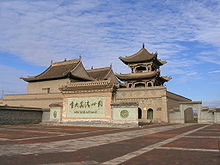Tongxin Great Mosque
| Tongxin Great Mosque | |
|---|---|
同心清真大寺 | |
 | |
| Religion | |
| Affiliation | Islam |
| Branch/tradition | Sunni |
| Location | |
| Location | Tongxin, Wuzhong, Ningxia, China |
 Shown within Ningxia | |
| Geographic coordinates | 36°57′54″N 105°54′40″E / 36.96501°N 105.91124°ECoordinates: 36°57′54″N 105°54′40″E / 36.96501°N 105.91124°E |
| Architecture | |
| Type | mosque |
| Capacity | 1,000 worshipers |
The Tongxin Great Mosque (Chinese: 同心清真大寺; pinyin: Tóngxīn Qīngzhēndàsì)[1] is a mosque in Tongxin County, Wuzhong City, Ningxia Hui Autonomous Region, China. The mosque is the oldest and largest mosque in Ningxia.[2]
History[]
The mosque was likely built in the fourteenth century during the Yuan Dynasty.[3] It was originally a Mongolian Buddhist temple that was eventually abandoned after the fall of the Yuan Dynasty in 1368. It was reconsecrated as a mosque during the early Ming dynasty.[4] The mosque underwent major renovations in the sixteenth century, in 1791 and in 1907.[3] The mosque was further expanded in 1936.[4] When the Chinese Workers' and Peasants' Red Army went on a westward campaign in 1936 liberating areas in Ningxia, they held a meeting with the local people at the mosque. They also set up the Yuhai County People's Government in Shanganning. In 1983, it was recognized as the National Key Cultural Relics Protection Unit by the State Council.[5] Today, the mosque is affiliated with the Yihewani sect.[6]
Architecture[]
The mosque was built in Han style[1] and decorated in Islamic style, which showcase the combination of Han and Hui culture. All of the buildings were built on a cyan platform, seven meters high. There is an imitation-timber work entrance wall, decorated with brick carvings, at the front gate. The main building, consisting of the main prayer hall and two connecting halls, accommodates 1,000 worshipers.[7] Behind the mosque lies a cemetery which also contains the shrines of two Sufi saints (or Shaykhs).[6]
Transportation[]
The mosque is accessible by bus from the Yinchuan Railway Station.[8]
See also[]
References[]
- ^ a b Hagras, Hamada (2019). "XI'AN DAXUEXI ALLEY MOSQUE: HISTORICAL AND ARCHITECTURAL STUDY". Egyptian Journal of Archaeological and Restoration Studies "EJARS". 1: 97–113.
- ^ "Tongxin Great Mosque _ China.org.cn". china.org.cn. Archived from the original on 31 December 2013. Retrieved 22 January 2015.
- ^ a b Dillon, Michael (1996). China's Muslims. Hong Kong: Oxford University Press. pp. 41. ISBN 0195875044.
- ^ a b Steinhardt, Nancy Shatzman (2015). China's Early Mosques. Edinburgh: Edinburgh University Press. p. 219. ISBN 978-1-4744-3721-9.
- ^ "Tongxin Mosque". chinaculture.org. Archived from the original on 7 November 2016. Retrieved 7 November 2016.
- ^ a b Dillon, Michael (1996). China's Muslims. Hong Kong: Oxford University Press. pp. 42. ISBN 0195875044.
- ^ "Tongxin Great Mosque". chinaculture.org. Archived from the original on 7 November 2016. Retrieved 7 November 2016.
- ^ "Tongxin Mosque". at0086.com. Archived from the original on 22 January 2015. Retrieved 22 January 2015.
- Buildings and structures in Ningxia
- Major National Historical and Cultural Sites in Ningxia
- Ming dynasty architecture
- Mosques in China
